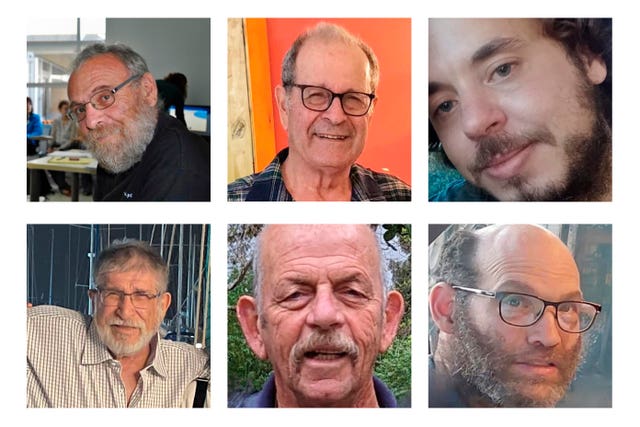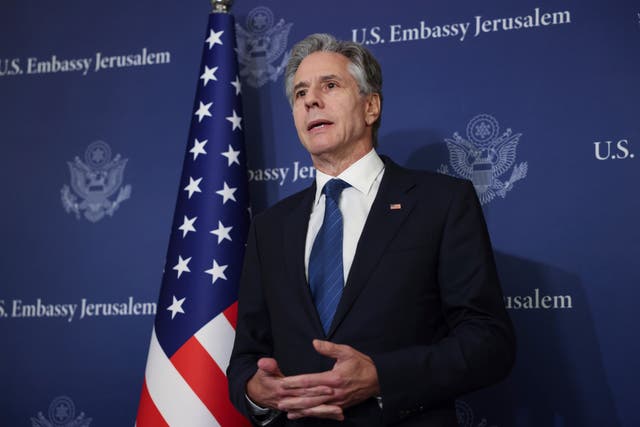Gap remains wide between Hamas and Israel over Gaza ceasefire despite US efforts
US secretary of state Antony Blinken is meeting fellow mediators but Hamas and Israel signal that big challenges remain.

US secretary of state Antony Blinken is visiting fellow mediators Egypt and Qatar as Hamas and Israel signal that challenges remain in efforts to secure a ceasefire in Gaza.
Hamas said in a statement that the latest proposal presented to it was a “reversal” of what it agreed to previously and accused the US of acquiescing to what it called “new conditions” from Israel.
Israeli Prime Minister Benjamin Netanyahu, meanwhile, met with groups of families of fallen soldiers and hostages in Gaza. The groups, which oppose a ceasefire deal, said Mr Netanyahu told them Israel will not abandon two strategic corridors in Gaza whose control by Israel has been an obstacle in the talks. Mr Netanyahu’s office did not comment on their account.

A senior US official rejected as “totally untrue” Mr Netanyahu’s alleged comments that he had told Mr Blinken that Israel would never leave the Philadelphi and Netzarim corridors.
Mr Netanyahu’s meeting came as Israel’s military said it recovered the bodies of six hostages taken in Hamas’s October 7 attack that started the war, bringing fresh grief for many Israelis who have long pressed Mr Netanyahu to agree to a ceasefire that would bring remaining hostages home.
Mr Blinken’s meetings in Egypt and upcoming ones in Qatar come a day after he met in Israel with Mr Netanyahu and said the prime minister had accepted a US proposal to bridge gaps separating Israel and Hamas. Mr Blinken called on the militant group to do the same.
But there still appear to be wide gaps between the two sides, though angry statements often serve as pressure tactics during negotiations.

Pressure to seal a ceasefire deal has been especially urgent after the recent targeted killings of militant leaders of Hamas and Hezbollah in Iran and Lebanon, both blamed on Israel, and vows of retaliation that have sparked fears of a wider regional war.
Israel’s military said its forces recovered the bodies in an overnight operation in southern Gaza, saying they were killed during a time that troops were operating in Khan Younis. Hamas says some captives have been killed in Israeli air strikes, though returning hostages have talked about difficult conditions in captivity, including lack of food or medications.
The recovery of the remains is a blow to Hamas, which hopes to exchange hostages for Palestinian prisoners, an Israeli withdrawal and a lasting ceasefire.
The military said it had identified the remains of Chaim Perry, 80; Yoram Metzger, 80; Avraham Munder, 79; Alexander Dancyg, 76; Nadav Popplewell, 51; and Yagev Buchshtav, 35. Metzger, Munder, Popplewell and Buchshtav had family members who were also abducted but freed during a November ceasefire.

Mr Munder’s death was confirmed by Kibbutz Nir Oz, the farming community where he was among around 80 residents who were taken captive. It said he died “after enduring months of physical and mental torture”. Israeli authorities had previously determined that the other five were deceased.
Hamas is still believed to be holding around 110 hostages captured in the October 7 attack. Israeli authorities estimate around a third of them are dead.
Hamas-led militants burst through Israel’s defences on October 7 and rampaged across the south, killing some 1,200 people, mostly civilians, and taking around 250 people hostage. Over 100 hostages were released in exchange for Palestinians imprisoned in Israel during a week-long ceasefire last year.
Israel’s retaliatory offensive has killed more than 40,000 Palestinians, according to Gaza’s Health Ministry, which does not say how many were militants. Air and ground operations have caused widespread destruction and forced the vast majority of Gaza’s 2.3 million residents to flee their homes, often multiple times. Aid groups fear the outbreak of diseases like polio.

An Israeli air strike on Tuesday killed at least 12 people at a school-turned-shelter in Gaza City, in what the military said was a precise strike on a Hamas command centre. Another strike killed a mother and her five children in central Gaza.
The Palestinian Civil Defence, first responders operating under the Hamas-run government, said it was still searching for survivors after the strike on the Mustafa Hafez school in Gaza City. It said around 700 people were sheltering at the school when it was hit.
The Israeli military said the strike targeted Hamas militants who had set up a command centre inside the school and were planning and launching attacks.
An Israeli air strike in central Gaza killed five children and their mother, according to the nearby Al-Aqsa Martyrs Hospital, where an Associated Press reporter counted the bodies. The hospital said the father, Alaa Abu Zeid, a schoolteacher, has been in Israeli detention for the last nine months.





